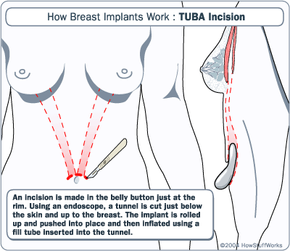TUBA Incision
The TUBA (trans-umbilical breast augmentation) incision, or the bellybutton incision, is much less common than the other three. This incision is made in the rim of the bellybutton. Then, using an endoscope, a tunnel is cut through the subcutaneous fat just below the skin all the way to behind the breast. As in all techniques, a pocket is then cut for the implant. The implant is rolled up and pushed through the tunnel into place.
In this technique, the implant is filled before the incision is closed using a fill tube that is snaked through that tunnel. The surgeon uses the endoscope to make sure everything is in place and then closes the incision.
Advertisement
While this may seem extreme, this is actually one of the least invasive techniques. The skin on the abdomen has greater elasticity than other types of skin and can take the tunneling. Very rarely, this procedure leaves "V" tracks on the stomach. Overall, the scarring and recovery time is far less with a TUBA incision than with the other three.
There are limitations with the TUBA incision:
- The procedure requires inflatable implants.
- TUBA can only be used for sub-pectoral or sub-muscular placement.
- In the event of complication or revision, the TUBA incision (like the armpit incision) cannot be reused -- the surgeon will have to make a nipple or crease incision to work on the implant.
- Few plastic surgeons are willing or able to perform it -- this procedure makes for the greatest room for error when placing the implant due to the distance from the breast.
In the next section, we will look at some of the risks associated with breast augmentation surgery.
